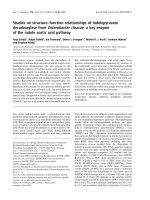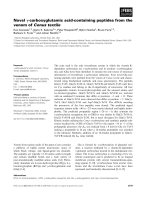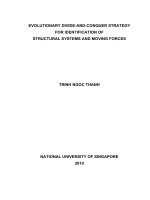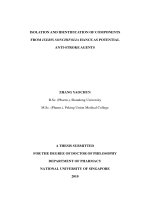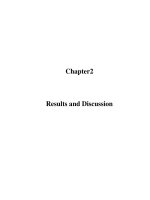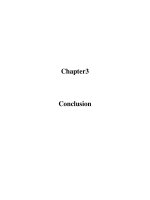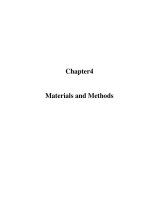Isolation and identification of indole acetic acid producing bacteria from the coasts of Ben Tre and Tra Vinh provinces
Bạn đang xem bản rút gọn của tài liệu. Xem và tải ngay bản đầy đủ của tài liệu tại đây (983.27 KB, 13 trang )
TAP CHI SINH HOC 2019, 41(4): 55–67
DOI: 10.15625/0866-7160/v41n4.13869
ISOLATION AND IDENTIFICATION OF INDOLE ACETIC ACID
PRODUCING BACTERIA FROM THE COASTS
OF BEN TRE AND TRA VINH PROVINCES
Nguyen Ngoc Lan1,2, Vu Van Dung1,2,3, Nguyen Thi Kim Lien1,
Nguyen Kim Thoa4, Do Huu Nghi5, Nguyen Huy Hoang1,*
1
Institute of Genome Research, VAST, Vietnam
Graduate of Science and Technology, VAST, Vietnam
3
Institute of Chemistry and Materials, Academy of Military Science and Technology, Vietnam
4
Institute of Biotechnology, VAST, Vietnam
5
Institute of Natural Products Chemistry, VAST, Vietnam
2
Received 11 June 2019, accepted 18 October 2019
ABSTRACT
Beneficial plant-growth-promoting bacteria (PGPB) have been reasonably applied to rescue
crucial issue for agriculture by salinity soil. Observed most of PGPB was found in endophyte,
rhizosphere and soil. Indole acetic acid (IAA)-producing bacteria could naturally stimulate and
facilitate plant growth. The knowledge of IAA production and content of bacteria resident in the
marine environment has been typically insufficient and limited to date. In recent years,
unwarrantable intrusions of sea water have been enlarged in the Mekong River Delta of Vietnam,
threatening productive rice fields, local fruits, and cash crops. Therefore, finding PGPB in the
coastal regions in the Mekong River Delta as a creative resource for sustainable agriculture is
necessary and is a prompt challenge. In this study, IAA-producing bacteria from coastal regions
of Ben Tre and Tra Vinh Provinces were isolated and adequately identified. Out of 202 bacterial
isolates, 10 isolates showed the possible ability to produce IAA from L-tryptophan. These 10
isolates were objectively evaluated the capacity to produce IAA under 5% (w/v) NaCl in King B
and marine broths. The results revealed that IAA production decreased in 5% NaCl, even though
bacterial growth increased. These 10 IAA-producing bacteria were classified at the species level,
Marinobacter hydrocarbonoclasticus, M. pelagius, M. daepoensis, and Mameliella phaeodactyli
by 16S rRNA gene analysis. The most IAA producer in King’s B broth, the isolate C7, was
investigated in more detail. The isolate C7 produced the maximum IAA amount (192.2 ± 1.14
µg/ml) under the presence of 20 g/l yeast extract, 2 g/l of L-tryptophan and 1% NaCl. The isolate
C7 was able to grow at 1–17% (w/v) NaCl (optimum, 4%), but not in the absence of NaCl,
indicating it is a moderate halophilic bacterium. This study highlighted the considerable ability to
produce IAA of marine bacteria, which could be thoughtfully considered to use naturally as
biofertilizers to promote plant growth in saline intrusion lands.
Keywords: IAA producing bacteria, marine, Marinobacter, Mameliella, C7, halophile.
Citation: Nguyen Ngoc Lan, Vu Van Dung, Nguyen Thi Kim Lien, Nguyen Kim Thoa, Do Huu Nghi, Nguyen Huy
Hoang, 2019. Isolation and identification of indole acetic acid producing bacteria from the coasts of Ben Tre and Tra
Vinh Provinces. Tap chi Sinh hoc (Journal of Biology), 41(4): 55–67. />*
Corresponding author email: /
©2019 Vietnam Academy of Science and Technology (VAST)
55
Nguyen Ngoc Lan et al.
INTRODUCTION
Indole acetic acid (IAA) represents the
member of the auxin group that have the
ability to improve plant growth by stimulating
cell elongation and division, tissue
differentiation, seed germination and seedling
growth (Prinsen et al., 1993). Indole acetic
acid is synthesized in many species of many
bacteria, fungi, algae, and plants (Tsavkelova
et al., 2006; Fahad et al., 2015). The synthesis
of IAA in bacteria has been known for a long
time that ordinarily occurs via multiple
pathways as has been typically observed in
plants. Tryptophan carries out a crucial role as
the primary precursor for the synthesis of IAA
so that the addition of tryptophan to culture
media results in higher IAA production
(Glickmann & Dessaux, 1995). Bacteria can
synthesize IAA via tryptophan-dependent or independent pathways. There are at least five
distinct pathways for the synthesis of IAA
from tryptophan (Spaepen et al., 2007). These
possible pathways were identified based on
intermediates. The indole-3-acetamide (IAM)
pathway is the most popular pathway in
bacteria. Tryptophan is firstly converted to
IAM
by
enzyme
tryptophan-2monooxygenase. Subsequently, IAM is
efficiently converted to IAA by IAM
hydrolase. This specific pathway has been
illustrated in some bacteria, like Agrobacteria
tumefaciens (Mashiguchi et al., 2018),
Arthrobacter pascens (Li et al., 2018)
Pseudomonas chlororaphis (Dimkpa et al.,
2012), and Bradyrhizobium spp. (Sekine et al.,
1988). The indole-3-pyruvate (IPyA) pathway
is observed in plant growth promoter bacteria,
like Pseudomonas putida (Patten & Glick,
2002) and Rhizobium tropici (Imada et al.,
2017). Initially, the intermediate IPyA is
transferred
from
tryptophan
by
aminotransferase. Then, IPyA is converted to
indole -3- acetaldehyde (IAAld) by indole-3pyruvate decarboxylase and finally IAAld is
oxidized to IAA. Three remaining pathways
consisting of tryptamine, tryptophan sidechain oxidase and indole-3-acetonitrile have
been identified in some bacteria, such as
Azospirillum brasilence (Bar & Okon, 1993),
Pseudomonas fluorescens (Oberhänsli et al.,
56
1991), and Rhizobium spp. (Kobayashi et al.,
1995), respectively.
Sea water has been intruded into many
coastal areas in the Mekong River Delta of
Vietnam, threatening productive rice fields,
fruit, cash crops, and aquaculture (CGIAR
Research Centers in Southeast Asia, 2016).
Estimating, 25,900 ha of 400,000 ha of
cropland was left fallow. Rice areas affected
by drought and salinity intrusion rapidly
increased from 139,000 ha in mid-March
2016 to 224,552 ha by mid-April 2016.
Salinity intrusion have also affected 13,000 ha
of cash crops, 25,500 ha of fruit trees and
14,400 ha of aquaculture. Therefore, finding
the plant growth promoting bacteria in the
coastal regions in the Mekong River Delta of
Vietnam as a creative resource for agriculture
is necessary and challenge. The marine
environments contain a remarkably diverse
microorganisms, and they retain unique
properties to adapt to harsh condition like
high salt concentration with limited nutrition
(De Carvalho & Fermandes, 2010). Marine
microorganisms hold many applications in
biotechnology, such as production of enzymes
(Mohapatra et al., 2003; Trincone, 2011) and
pharmaceutical substances (Blunt et al., 2018;
Calado et al., 2018). Up to date, only a few
published studies have inspected plant growth
promoting activities of marine bacteria.
Bacteria Pseudomonas spp. olive green (OG)
isolated from marine water of the Gulf of
Khambhat showed an ability to produce 29
µg/ml IAA (Goswami et al., 2013).
Pseudomonas
aeruginosa
strain
BS8
produced 19 µg/ml IAA in the medium
supplemented with 500 µg/ml L-tryptophan
(Goswami et al., 2015). Nayomi & Thangavel
(2015) found 14 isolates which are able to
produce IAA in the nesessary presence of Ltryptophan. Therefore, isolation of IAAproducing salt-tolerant marine bacteria may
be one of the creative methods by which to
alleviate the environmental problem of
salinity and promoting the plant growth under
salinity. The aim of this study was to
investigate the IAA producing bacteria from
the coastal regions of Ben Tre and Tra Vinh
Provinces, Vietnam.
Isolation and identification of indole acetic acid
MATERIALS AND METHODS
Isolation and screening of IAA producing
bacteria
Six soil samples and six water samples
were carefully collected from the coastal
regions in Ben Tre Province (9.8334 N,
106.6597 E) and Tra Vinh Province (9.6199
N, 106.5592 E), Vietnam on April 27-28,
2017. Ten grams of sand or 10 ml of water
were mixed with 90 ml sterile distilled water
in 250 ml flask and shaken at 160 rpm for 10
min. The suspensions were serially diluted to
10-5 using sterile saline solution. An aliquot of
100 µl diluted samples was spread onto the
marine agar medium (Gellix, South of Korea)
supplemented with 5% (w/v) NaCl. The plates
were incubated at 30°C for up to 3 days.
Single colonies were selected and streaked on
sterile marine agar plates to properly obtain a
pure culture. Bacterial isolates were stored at 80°C in marine broth supplemented with 25%
glycerol or slant agar at 4°C.
Ability to produce IAA of isolates was
determined qualitatively following the
methods described by Glickmann & Dessaux
(1995), using King’s B broth [Per liter:
peptone 20 g; glycerol 10 ml; K2HPO4.3H2O
1.5 g; MgSO4.7H2O 1.5 g] supplemented
with 1 g/ml L-tryptophan and 5% (w/v)
NaCl. After incubation at 30°C for 5 days,
the
supernatant
was
collected
by
centrifugation at 8,000 rpm for 5 min. One
ml of the supernatant was mixed with 2 ml of
Salkowski’s reagent [FeCl3 12 g/l in 7.9 M
sulfuric acid solution] and kept in the dark
for 30 min to develop pink colour, indicating
IAA production.
Assement of IAA production in King’s B
and marine broths
To assess the effect of saline on the ability
of IAA production, the isolates were
inoculated in King’s B broth supplemented
with 5% (w/v) NaCl and marine broth [Per
liter: peptone 5 g; yeast extract 1 g; C6H5FeO7
0.1 g;
NaCl 19.45 g; MgCl2 5.9 g;
MgSO4.7H2O 3.24 g; CaCl2 1.8 g; KCl 0.55g;
NaHCO3 0.16 g; KBr 0.08 g; SrCl2 34 mg;
H3BO3 22 mg; Na2SiO3 4 mg; NH4NO3 1.6
mg; Na2PO4 8 mg] with 3% (w/v) NaCl to
achieve a final concentration of 5% (w/v)
NaCl. King’s B broth and marine broth
without supplementary NaCl were used for
comparison. L-tryptophan was added to all
media to make up final concentration of 1.0
g/L. Each experiment was carried out with
three replicates and the inoculums were
incubated at 180 rpm in a shaker incubator at
30°C in the dark for 5 days. After
centrifugation, 1 ml of the supernatant was
mixed with 2 ml of Salkowski’s reagent and
kept in the dark for 30 min. IAA production
was vigilantly measured by optical
densitometry at the wavelength of 530 nm.
Uninoculated broth served as a control. A
standard curve was prepared with 5–
100 μg/ml IAA (Sigma) for quantification.
Growth of bacterial strains was monitored by
measuring optical density at the wavelength of
600 nm.
Sequencing and analysis of 16S rRNA gene
The IAA producing isolates were
identified in a traditional manner based on
the analysis of 16S rRNA gene sequencing
as described previously (Tran Bao Tram et
al. 2018).
Effects of nitrogen sources, L-tryptophan
and NaCl on growth and production of
IAA by the isolate C7
The growth and production of IAA by the
isolate C7, in the presence of yeast extract,
tryptone, meat extract, peptone, L-proline,
NaNO3, glycine, and urea were tested.
Ingredients of the media were as follows (per
litre): nitrogen, 20 g (yeast extract, tryptone,
meat extract, peptone) or 5 g (L-proline,
NaNO3, glycine, and urea); 1.5 g
K2HPO4.3H2O; 1.5 g MgSO4.7H2O; 10 g
NaCl and 1 g L-tryptophan.
The effect of L-tryptophan was checked
employing the above medium with yeast
extract as nitrogen and supplemented with 1%
(w/v) NaCl. The concentration of Ltryptophan varied from 0 to 3 g/l (at intervals
of 0.5 g/l).
57
Nguyen Ngoc Lan et al.
The effect of NaCl was examined at the
concentrations of 0, 1, 2, 4, 5, 6, 8, 9, 10, 12,
14, 15, 17 and 20% (w/v) NaCl in the medium
containing (per litre) 20 g yeast extract, 1.5 g
K2HPO4.3H2O, 1.5 g MgSO4.7H2O, and 2 g
L-tryptophan.
Starter culture was prepared in 20 ml of
marine broth and incubated overnight at 30°C
with continuous shaking at 160 rpm. Each test
was carried out with three replicates.
Measurements of IAA and growth were
carried out as above. Optical densities higher
than 2.99, were measured after an appropriate
dilution and the readings were multiplied with
the dilution factor.
RESULTS
Isolation of bacteria and screening of IAA
producing bacteria
A total of 202 bacterial colonies was
isolated from 12 samples collected from
coastal regions of Ben Tre and Tra Vinh
Provinces. All isolates were evaluated for the
ability to produce IAA by the Salkowski
method. Ten out of 202 colonies were able to
produce IAA and were designated BDS 1.2.2,
BDW 1.1.1, BDW 1.1.2, BDW 1.1.3, B9, B7,
CBW 1.1.1, CBW 1.1.3, CBW 2.2.3 and C7
(table 1). All of them were identified as gramnegative and rod-shaped.
Table 1. Information of IAA-producing bacterial strains isolated in the coastal regions
of Ben Tre and Tra Vinh Provinces
No.
Isolates
Isolation source
Colony
White, circular, entire,
1
BDS 1.2.2
Sands, Ba Dong coast, Tra Vinh
elevated, opaque, mucoid
White, circular, entire,
2
BDW 1.1.1
Seawater, Ba Dong coast, Tra Vinh
elevated, mucoid
White, circular, entire,
6
BDW 1.1.2
Seawater, Ba Dong coast, Tra Vinh
elevated, mucoid
White, circular, entire,
7
BDW 1.1.3
Seawater Ba Dong coast, Tra Vinh
elevated, mucoid
Opalescent, circular, entire,
9
B9
Seawater, Ba Dong coast, Tra Vinh
elevated, mucoid
Opalescent, circular, entire,
10 B7
Seawater, Ba Dong coast, Tra Vinh
elevated, mucoid
White, circular, entire,
3
CBW 1.1.1
Seawater, Con Bung coast, Ben Tre
elevated, mucoid
White, circular, entire,
4
CBW 1.1.3
Seawater, Con Bung coast, Ben Tre
elevated, mucoid
White, circular, entire,
5
CBW 2.2.3
Seawater, Con Bung coast, Ben Tre
elevated, mucoid
Opalescent, circular, entire,
8
C7
Seawater, Con Bung coast, Ben Tre
elevated, mucoid
Assessment of IAA production in King’s B
and marine broths
As King’B is a basic medium to test IAA
producing activity and marine broth is a
native habitat of marine bacteria, we used
these two media for the assessment of IAA
production. Fig. 1 illustrates the growth and
58
IAA production of the ten bacterial isolates.
Isolates BDW 1.1.1, CBW 2.2.3, and BDW
1.1.3 could grow well in all conditions, in
contrast the other strains were able to grow
better in moderate halophilic conditions
(Fig. 1a). The best growths of isolate BDW
1.1.1; isolates CBW 2.2.3 and BDW 1.1.3
were observed in King’B broth and King’B
Isolation and identification of indole acetic acid
broth supplemented with 5% (w/v) NaCl,
respectively. Isolates BDS 1.2.2, CBW 1.1.1,
CBW 1.1.3, C7, B7 and B9 displayed the best
growth in marine broth supplemented with 3%
(w/v) NaCl.
King B + 1g/l L-tryptophan
MB + 1g/l L-tryptophan
King B + 1g/l L-tryptophan +5% NaCl
MB + 1g/l L-tryptophan +3% NaCl
(a)
1.6
1.4
OD 600 nm
1.2
1
0.8
0.6
0.4
0.2
0
(b)
BDS
1.2.2
BDW
1.1.1
CBW
1.1.1
CBW
1.1.3
CBW
2.2.3
BDW
1.1.2
BDW
1.1.3
C7
B9
B7
BDS
1.2.2
BDW
1.1.1
CBW
1.1.1
CBW
1.1.3
CBW
2.2.3
BDW
1.1.2
BDW
1.1.3
C7
B9
B7
IAA concentration (mg/ml)
80
70
60
50
40
30
20
10
0
Figure 1. Growth (a) and IAA production (b) in saline and non-saline conditions
by ten bacterial isolates
The isolate C7 was identified to be the
most efficient IAA producing isolate in all
conditions, compared to the other strains (Fig
1b). In details, the isolate C7 produced 76.49
mg/ml IAA in King’ B broth and 33.05 mg/ml
IAA in marine broth supplemented 3% (w/v)
NaCl. Isolates B7 and B9 also produced the
high amounts of IAA in marine broth with
61.82 mg/ml and 61.54 mg/ml, respectively.
Isolates BDW1.1.1, CBW 2.2.3, BDW 1.1.2,
BDW 1.1.3, and B9 produced greater amount
of IAA in marine broth than in King’B broth.
In contrast, isolates BDS 1.2.2, CBW 1.1.1,
CBW 1.1.3, C7, and B7 showed the most
59
Nguyen Ngoc Lan et al.
effective IAA production at the most limited
growth in King’B broth, compared to the rest
of the other conditions (Fig. 2). Under the
presence of higher NaCl, IAA productions
were significantly decreased, showing that
higher NaCl is unfavorable to IAA production
of bacterial isolates.
Figure 2. Ratio of optical density of bacterial growth to IAA production (IAA/OD 600 nm)
in saline and non-saline conditions by ten bacterial isolates
Species identification of bacteria isolates
using 16S rRNA gene sequence
The 16S rRNA gene of the ten IAA
producing isolates was sequenced and
compared with those available from the
GenBank database (table 2). Based on 16S
rRNA gene sequence similarity, the isolate
BDS 1.2.2 was identified as Mameliella
phaeodactyli (99.85%); the isolate BDW
1.1.1 was classified as Marinobacter
daepoensis (99.93%); the isolates CBW
1.1.1, CBW 1.1.3, CBW 2.2.3, BDW 1.1.2,
and BDW 1.1.3 were identified to be
Marinobacter
hydrocarbonoclasticus
(99.86–100%); and isolates C7, B9, and B7
were the members of Marinobacter pelagius
(99.09%). Interestingly, bacterial isolates
producing IAA were the representatives of
the genus Marinobacter. The sequences data
has been submitted to GenBank database
60
under the accession numbers given in
table 2.
Maximum-likelihood phylogenetic tree
clearly illustrated the taxonomic positions of
the ten IAA-producing bacterial strains
(Fig. 3). The isolate BDS 1.2.2 together with
the type strain Mameliella phaeodactyli
KD53T represented a monophyletic separate
genus-level lineage. The genus Marinobacter
is divided into three groups. The group I was
formed by the isolates CBW 1.1.1, CBW
1.1.3, CBW 2.2.3, BDW 1.1.2, and BDW
1.1.3 and the type strain Marinobacter
hydrocarbonoclasticus ATCC 49840T. In
group II, the isolate BDW 1.1.1 clustered with
the type strain Marinobacter daepoensis SW156T with 100% bootstrap support. Three
isolates C7, B7, and B9 grouped with the type
strain Marinobacter pelagius HS 255T in
group III.
Isolation and identification of indole acetic acid
Table 2. BLASTN analysis of 10 IAA-producing isolates showing
the closest species in GenBank database
Length
NCBI
No.
Isolate
Top-hit taxon
Identity (%)
(bp)
Accession
1 BDS 1.2.2
1390
MK850321 Mameliella phaeodactyli
99.85
2 BDW 1.1.1
1480
MK850322 Marinobacter daepoensis
99.93
Marinobacter
3 CBW 1.1.1
1480
MK850323
99.86
hydrocarbonoclasticus
Marinobacter
4 CBW 1.1.3
1482
MK850324
99.93
hydrocarbonoclasticus
Marinobacter
5 CBW 2.2.3
1430
MK850325
99.86
hydrocarbonoclasticus
Marinobacter
6 BDW 1.1.2
1481
MK850326
100
hydrocarbonoclasticus
Marinobacter
7 BDW 1.1.3
1428
MK850327
100
hydrocarbonoclasticus
8 C7
1480
MK850328 Marinobacter pelagius
99.09
9 B9
1484
MK850329 Marinobacter pelagius
99.09
10 B7
1484
MK850330 Marinobacter pelagius
99.09
BDW 1.1.2 (MK850326)
56 Marinobacter hydrocarbonoclasticus ATCC 49840T (FO203363)
Group I
BDW 1.1.3 (MK850327)
100 CBW 1.1.1 (MK850323)
68 CBW 2.2.3 (MK850325)
99
CBW 1.1.3 (MK850324)
BDW 1.1.1 (MK850322)
100Marinobacter daepoensis SW-156T (AY517633) Group II
Marinobacter pelagius HS225T (DQ458821)
98
C7 (MK850328)
Group III
99
69 B7 (MK850330)
B9 (MK850329)
100 BDS 1.2.2 (MK850321)
0.02
Mameliella phaeodactyli KD53T (KJ850205.1)
Figure 3. The maximum-likelihood phylogenetic relationship of IAA producing marine bacteria
based on 16S rRNA sequence analysis. Marine bacteria isolates are shown in bold with their
nucleotide sequence accession numbers indicated in brackets. The significance of each branch is
indicated by a bootstrap value 50 are indicated for each node (1,000 replicates). Bar, 0.01
substitution per nucleotide position
Effect of nitrogen sources, L-tryptophan
and NaCl on growth and production of
IAA by the isolate C7
The effects of different nitrogen sources
on the IAA production and the growth of the
isolate C7 were shown in Figure 4a. No
growth was observed in glycine (Fig. 4a). The
isolate C7 was able to grow slowly under the
presence of urea and NaNO3 but grow well in
yeast extract, meat extract, peptone and
tryptone (Fig. 4a). Among them, yeast extract
61
Nguyen Ngoc Lan et al.
was found to serve as the most suitable source
for IAA production (148.16±0.31 µg/ml).
Meat extract, peptone, and tryptone also
resulted in the intense production of IAA
(124.38±0.37; 112.24±0.46; và 93.46±0.71
µg/ml, respectively). Under the presence of Lproline, a moderate amount of IAA
(54.40±0.05 µg/ml) was produced (Fig. 4a).
The most poor IAA production was observed
under the presence of urea and NaNO3 (IAA
concentration < 20 µg/ml). Although the
isolate C7 showed the steadiest growth in
peptone, the highest IAA production was
achieved in yeast extract. Growth ability as
well as IAA production of the isolate C7 was
low in NaNO3 and urea.
To identify the optimum concentration of
L-tryptophan on IAA production by the
isolate C7, the isolate C7 was cultured under
the presence of various concentrations of L-
tryptophan (0 to 3 g/l) (Fig. 4b). IAA
production was gradually increased starting at
0.5 g/l, reached its peak (191 ± 1.52 µg/ml) at
2.0 g/l, and then decreased along with the
increase of L-tryptophan concentration up to
to 3 g/l. The growth of the isolate C7
gradually decreased in proportional with the
increase of the L-tryptophan concentration
(Fig. 4b).
The isolate C7 was able to grow and
produce IAA over a broad range (1–17%) of
NaCl with the optimum growth at 4% (Fig. 4c),
but unable to grow without NaCl. No growth
was observed at 20% (w/v) NaCl. The highest
IAA production by the isolate C7 (192.2 ± 1.14
µg/ml) was obtained at 1% NaCl. The IAA
production by the isolate C7 gradually
decreased when the NaCl concentration
increased (Fig. 4c). IAA was not produced at
the NaCl concentration of 15%.
Figure 4. Effect of nitrogen sources, L-tryptophan and salt on growth and IAA production
of isolate C7: a) Nitrogen sources; b) L-tryptophan; c) NaCl
62
Isolation and identification of indole acetic acid
DISCUSSION
Recent assessments have documented salt
intrusions in Mekong River Delta. Numerous
studies have reported IAA-producing salt
tolerant bacteria from rice plants (Nguyen
Van Minh, 2017), and from the soil of riceshrimp farming systems in the Mekong Delta,
Vietnam (Nguyen Khoi Nghia et al., 2017).
Almost all the studies on marine bacteria have
typically focused on their antibiotic (Wiese &
Imhoff, 2019); degradation capability of
plastic (Urbanek et al., 2018), oil (Farag et al.,
2018), and petroleum hydrocarbon (Mahjoubi
et al., 2018). Research on plant growth
promoting activity of marine bacteria is
limited. The study of Uchgaonkar et al. (2018)
screened siderophore producing bacteria in
sea water in India. In case of IAA production,
the study of Nayomi & Thangavel (2015)
screened IAA producing bacteria from sea
water and sediment in India. As the
development of new sources for IAA
producing bacteria from marine environments
is promising, in this study, we investigated the
ability to produce IAA of bacteria isolated
from the marine environment in Vietnam. The
number of IAA-producing isolates from
coastal regions of Ben Tre and Tra Vinh
Provinces was considerably low compared
with that of Thiruvananthapuram, India
(Nayomi & Thangavel, 2015). This difference
may relate to the different sampling. In
details, in the study of Nayomi & Thangavel
(2015), they isolated bacteria from marine
water and sediments, but in this study we
isolated from marine water and sands.
Sediment may have more diverse bacteria
than sands. The number of IAA-producing
bacterial
isolates
from
the
marine
environment was similar with that found in
rhirosphere soils from banana, cotton, maize
and wheat (Mohite, 2013), but lower than
those found in the rhizosphere of halophyte or
soils (Siddikee et al., 2010).
In contrast to the studies of Goswami et al.
(2013, 2015) and Nayomi & Thangavel
(2015), in which bacterial strains of the genera
Pseudomonas and Acinectobacter produced
IAA, in this study no such genera were
obtained. On the other hand, this study is the
first on the ability of IAA production from
Marinobacter spp. and Mameliella spp.
Therefore, our study established the potential
for ubiquitous IAA-producing bacteria in the
marine environment. This suggests marine
bacteria could be a creative source for the use
of these bacteria as biofertilizers to improve
the growth and crop productivity in saline
intrusion lands.
In this study, we also investigated several
factors affecting the growth and IAA
production of the isolate C7. Due to the
optimal growth at 4% NaCl and no growth at
0% NaCl, the isolate C7 was characterized as
a moderate halophilic strain as classified
previously by Kushner (1978). The salt
tolerance of the isolate C7 was similar with
the type strain of Marinobacter pelagius (Xu
et al., 2008). Based on 16S rRNA gene
sequence, we identified the isolate C7 as
Marinobacter Pelagius. Hereafter, we
designate the isolate C7 as Marinobacter
pelagius strain C7.
As a moderate halophile, M. pelagius
strain C7 grew better in marine broth than
King’B broth, but produced IAA most
effectively in King’B. It can be explained that
the high concentration of NaCl in marine
broth (1.95%) could affect to IAA production
of the strain C7. This is confirmed further by
examining the dose-effect of NaCl to IAA
production of the strain C7 (Fig. 3c), in
which, the IAA production was significantly
decreased from 2% NaCl after reaching its
peak at 1% NaCl. Synthesis of IAA from Ltryptophan consists of membrane-bound and
extracellular enzymes, of which enzyme
activity is considerably affected by external
saline conditions (Ventosa et al., 1998). These
processes are different between bacteria
groups. In case of salt-sensitive bacteria
Bradyrhirobium PN13-3, approximate 30%
and 100% IAA reduction was observed at 200
mM and 400 mM NaCl, respectively,
indicating high salt concentrations inhibited
the enzyme activity (Dong et al., 2017). In
contrast, salt-tolerant bacteria Bradyrhirobium
RJS9-2, IAA production significantly
63
Nguyen Ngoc Lan et al.
increased about 20% and 30% at 200 nM
NaCl and 400 mM NaCl, respectively,
compared to no NaCl (Dong et al., 2017). It
could be suggested that enzyme activity was
stimulated by salt concentration up to 400
mM. As another possible explanation, IAA
production might raise the salt-tolerant strain
RJS9. In the study of Dong et al. (2017) at the
concentration of 500 mM, osmoprotective
compounds of strain RJS9 decreased,
indicating that strain RJS9 started salt
sensitivity at this concentration. In our study,
the strain C7 is a moderate halophilic
bacterium and can grow abundantly at an
approximate NaCl concentration of 855 mM,
but IAA production reduced nearly 50%,
compared to non-saline (Fig. 1). Indeed,
concentration of 855 mM NaCl is high that
inhibits enzyme activity, including enzymes
involved in synthesis of IAA from Ltryptophan.
The strain C7 had limitations in carbon
utilization but could use peptone in King’B
and marine broths. Therefore, we tested the
effect of nitrogen sources to the ability of IAA
production of this strain, such as yeast extract,
meat extract, peptone, tryptone, L-proline,
urea and NaNO3. Yeast extract was the best
nitrogen source for IAA production for the
strain C7. This is consistent with that
observed in Pseudomonas sp. (Balaji et al.,
2012) and Enterobacter sp. (Nutarata et al.,
2017). The strain C7 could not grow under the
presence of glycine, suggesting that cells of
the strain C7 were susceptible to glycine.
Glycine induced the lysis of various
microorganisms such as Bacillus subtilis,
Escherichia coli, Bacteroides ruminicola,
Streptomyces sp., Pseudomonas sp. etc.
(Hishinuma et al., 1969). Glycine also
inhibited the growth of diverse bacterial
species by inhibiting cell wall synthesis
(Hammes et al., 1973). Glycine has been
demonstrated to incorporate into the
nucleotide-activated
peptidoglycan
precursors, resulting accumulation of glycinecontaining precursors which lead to a
disturbance of the normal balance between
peptidoglycan synthesis and controlled
64
enzymatic hydrolysis during growth. The
strain C7 is a gram-negative bacterium, which
owns a thin cell wall, and therefore, cell wall
may become weaker by no growth at 0.5%
glycine, compared to 80% inhibition of
growth at 0.55–10% glycine of gram-positive
bacteria such as Lactobacillus sp. and
Corynebacterium sp. (Hammes et al., 1973).
The presence of urea and NaNO3 at the
concentration of 0.5% (w/v) reduced the IAA
production, compared to the other favorable
organic nitrogen sources. This negative effect
has also been reported by Othman et al.
(2013), in which, nitrogen from urea lowered
the IAA production of Stenotrophomonas
maltophilia Sb16.
L-tryptophan is an IAA precursor, and as
a result, the supplementation of L-tryptophan
in the medium enhanced IAA biosynthesis.
The result of IAA production at 2 g/l Ltryptophan of the strain C7 in this study is
consistent with the previous studies of Park et
al. (2015) and Wagi & Ahmed (2019), who
also obtained maximum IAA productions of
2-3 g/l L-tryptophan for Enterobacter sp. and
Bacillus sp. However, other bacteria in the
study of Mohite et al. (2013) indicated the
optimum L-tryptophan concentrations ranging
from 0.5 to 15 g/l. This difference might be
attributed the different adaptability of each
bacterial strain to L-tryptophan. The optimum
L-tryptophan for IAA production may not be
the optimum L-tryptophan for growth of
bacteria. In this study, the strain C7 showed a
gradual decrease in the growth with
theincrease of L-tryptophan. It can be
explained that L-tryptophan could enhance
cellular reactive oxygen species generation,
causing bacterial death (Li et al., 2019).
CONCLUSION
This study highlights a diverse IAAproducing bacteria in marine origin belonging
to the genera Marinobacteria and Mameliella.
This is also the first report dealing with the
IAA-producing ability of these two genera.
The strain C7 belonging to Marinobacter
pelagius has shown promising plant growth
promoting activity indicated by IAA
Isolation and identification of indole acetic acid
production and can be used as bio-inoculants
in agricultural environments.
Acknowledgments: This research is funded by
Vietnam National Foundation for Science and
Technology Development (NAFOSTED)
under grant number 106-NN.04-2016.37.
REFERENCES
Balaji N., Lavanya S. S., Muthamizhselvi S.,
Tamilarasan K., 2012. Optimization of
fermentation condition for indole acetic
acid production by Pseudomonas species.
Int. J. Adv. Biotechnol. Res., 3: 797–803.
Bar T., Okon Y., 1993. Tryptophan
conversion to indole-3-acetic acid via
indole-3-acetamide
in
Azospirillum
brasilense sp7. Can. J. Microbiol., 39(1):
81–86.
Blunt J. W., Carroll A. R., Copp B. R., Davis
R. A., Keyzers R. A., Prinsep M. R.
Munro M H., Northcote P. T., Prinsep M.
R., 20112018. Marine natural products.
Nat. Prod. Rep., 2835(21): 1968–26853.
Calado R., Leal M. C., Gaspar H., Santos S.,
Marques A., Nunes M. L., Vieira Het al.,
2018. How to succeed in marketing
marine
natural
products
for
pharmaceutical, cosmetics & nutraceutical
markets. In: Rampelotto PH, & Trincone
A (eds) Grand Challenges in Marine
Biotechnology.
Springer,
Cham,
Switzerland, pp. 317–403.
CGIAR research centers in Southeast Asia,
2016. The drought and salinity intrusion
in the Mekong River Delta of Vietnam:
assessment report.
De Carvalho C., Fernandes P., 2010.
Production of metabolites as bacterial
responses to the marine environment.
Mar. Drugs., 8(3): 705–727.
Dimkpa C. O., Zeng J., McLean J. E., Britt D.
W., Zhan J., Anderson A. J., 2012.
Production of indole-3-acetic acid via the
indole-3-acetamide pathway in the plantbeneficial
bacterium
Pseudomonas
chlororaphis O6 is inhibited by ZnO
nanoparticles but enhanced by CuO
nanoparticles. Appl. Environ. Microbiol.,
78(5): 1404–1410.
Dong R., Zhang J., Huan H., Bai C., Chen Z.,
Liu G., 2017. High salt tolerance of a
Bradyrhizobium strain and its promotion
of the growth of Stylosanthes guianensis.
Int. J. Mol. Sci., 18(8): 1625.
Fahad S., Hussain S., Matloob A., Khan F. A.,
Khaliq A., Saud S., Hassan S., Shan D.,
Khan F., Ullah N., Faiq M., 2015.
Phytohormones and plant responses to
salinity stress: a review. Plant. Growth.
Regul., 75(2): 391–404.
Farag S., Soliman N. A., Abdel-Fattah Y.
R., 2018. Statistical optimization of
crude oil bio-degradation by a local
marine bacterium isolate Pseudomonas
sp. sp48. J. Genet. Eng. Biotechnol.,
16(2): 409–420.
Glickmann E., Dessaux Y., 1995. A critical
examination of the specificity of the
salkowski
reagent
for
indolic
compounds
produced
by
phytopathogenic
bacteria.
Appl.
Environ. Microbiol., 61(2): 793–796.
Goswami D., Patel K., Parmar S., Vaghela H.,
Muley N., Dhandhukia P., Thakker J. N.,
2015. Elucidating multifaceted urease
producing
marine
Pseudomonas
aeruginosa BG as a cogent PGPR and
bio-control agent. Plant. Growth. Regul.,
75(1): 253–263.
Goswami D., Vaghela H., Parmar S.,
Dhandhukia P., Thakker J. N., 2013. Plant
growth
promoting
potentials
of
Pseudomonas spp. strain OG isolated
from marine water. J. Plant. Interact.,
8(4): 281–290.
Hammes W., Schleifer K. H., Kandler O.,
1973. Mode of action of glycine on the
biosynthesis
of
peptidoglycan.
J.
Bacteriol., 116(2): 1029–1053.
Hishinuma F., Izaki K., Takahashi H., 1969.
Effects of glycine and D-amino acids on
growth of various microorganisms. Agri.
Biol. Chem., 33(11): 1577–1586.
65
Nguyen Ngoc Lan et al.
Imada E. L., de Oliveira A. L. M., Hungria
M., Rodrigues E. P., 2017. Indole-3-acetic
acid production via the indole-3-pyruvate
pathway by plant growth promoter
Rhizobium tropici CIAT 899 is strongly
inhibited by ammonium. Res. Microbiol.,
168(3): 283–292.
Kobayashi M., Suzuki T., Fujita T., Masuda
M., Shimizu S., 1995. Occurrence of
enzymes involved in biosynthesis of
indole-3-acetic acid from indole-3acetonitrile in plant-associated bacteria,
Agrobacterium and Rhizobium. Proc.
Natl. Acad. Sci. U S A., 92(3): 714–718.
Kushner D. J., 1978. Microbial life in extreme
environments. Academic Press.
Li M., Guo R., Yu F., Chen X., Zhao H., Li
H., Wu J., 2018. Indole-3-acetic acid
biosynthesis pathways in the plantbeneficial bacterium Arthrobacter pascens
ZZ21. Int. J. Mol. Sci., 19(2): 443.
Li Y., Liu B., Guo J., Cong H., He S., Zhou
H., Zhu F., Wang Q., Zhang L., 2019. LTryptophan represses persister formation
via inhibiting bacterial motility and
promoting antibiotics absorption. Future.
Microbiol., 14(9): 757–771.
Mahjoubi M., Cappello S., Souissi Y., Jaouani
A., Cherif, A., 2018. Microbial
bioremediation
of
petroleum
hydrocarbon–contaminated
marine
environments. In: Zoveidavianpoor M
(Ed) Recent Insights in Petroleum Science
and Engineering, 325. InTech, London,
UK, pp. 325–350.
Mashiguchi K., Hisano H., Takeda K. N.,
Takebayashi Y., Ariizumi T., Gao Y.,
Ezura H., Sato K., Zhao Y., Hayashi K. I.,
Kasahara H., 2018. Agrobacterium
tumefaciens enhances biosynthesis of two
distinct auxins in the formation of crown
galls. Plant. Cell. Physiol., 60(1): 29–37.
Mohapatra B. R., Bapuji M., Sree A., 2003.
Production
of
industrial
enzymes
(amylase, carboxymethylcellulase and
protease) by bacteria isolated from marine
66
sedentary organisms. Acta. Biotechnol.,
23(1): 75–84.
Mohite
B.,
2013.
Isolation
and
characterization of indole acetic acid
(IAA)
producing
bacteria
from
rhizospheric soil and its effect on plant
growth. J. Soil. Sci. Plant. Nutr., 13(3):
638–649.
Nayomi J., Thangavel M., 2015. Isolation,
screening and identification of marine
bacteria for the plant grwoth promoting
activites. Glob. J. Res. Anal., 4(11):
65–68.
Nguyen Khoi Nghia, Tran Thi My Tien,
Nguyen Thi Kieu Oanh, Nguyen Hoang
Kim Nuong., 2017. Isolation and
characterization of indole acetic acid
producing halophilic bacteria from salt
affected soil of rice–shrimp farming
system in the Mekong Delta, Vietnam.
Agriculture, Forestry and Fisheries., 6
(3): 69–77.
Nguyen Van Minh, Dinh Thi Hien, Nguyen
Bich Hoa, Nguyen Thi Mai Thi, Vo Ngoc
Yen Nhi, Duong Nhat Linh, Nguyen Bao
Quoc., 2017. Screening of salt tolerant
bacteria for plant growth promotion
activities and biological control of rice
blast and sheath blight disease on
mangrove rice. Vietnam. J. Sci. Technol.,
55(1A): 54–64.
Nutarata P., Monprasit A., Srisuk N., 2017.
High-yield production of indole-3-acetic
acid by Enterobacter sp. DMKU-RP206,
a rice phyllosphere bacterium that
possesses plant growth-promoting traits.
3. Biotech., 7: 305.
Oberhänsli T., Défago G., Haas D., 1991.
Indole-3-acetic acid (IAA) synthesis in
the biocontrol strain CHA0 of P.
fluorescens: role of tryptophan side
chain oxidase. Microbiology, 137(10):
2273–2279.
Othman R., Naher U. A., Yusoff S .Z., 2013.
Effect of urea-N on growth and
indoleacetic
acid
production
of
Stenotrophomonas maltophilia (Sb16)
Isolation and identification of indole acetic acid
isolated from rice growing soils in
Malaysia. Chil. J. Agr. Res., 73(2):
187–192.
Park J. M., Radhakrishnan R., Kang S. M.,
Lee, I. J., 2015. IAA producing
Enterobacter sp. I-3 as a potent bioherbicide candidate for weed control: a
special reference with lettuce growth
inhibition. Ind. J. Microbiol., 55(2):
207–212.
Patten C. L., and Glick B. R., 2002. Role of
Pseudomonas putida indoleacetic acid in
development of the host plant root
system. Appl. Environ. Microbiol., 68(8):
3795–3801.
Prinsen E., Costacurta A., Michiels K.,
Vanderleyden J., Van Onckelen H., 1993.
Azirospirillum brasilense indole-3-acetic
acid biosynthesis: Evidence for a nontryptophan dependent pathway. Mol.
Plant. Microbe. Interact., 6: 609–615.
Sekine M., Ichikawa T., Kuga N., Kobayashi
M., Sakurai A., Syōno K., 1988. Detection
of the IAA biosynthetic pathway from
tryptophan via indole-3-acetamide in
Bradyrhizobium spp. Plant. Cell. Physiol.,
29(5): 867–874.
Siddikee M. A., Chauhan P. S., Anandham R.,
Han G. H., Sa, T., 2010. Isolation,
characterization, and use for plant growth
promotion under salt stress, of ACC
deaminase-producing halotolerant bacteria
derived from coastal soil. J. Microbiol.
Biotechnol., 20(11): 1577–1584.
Spaepen S., Vanderleyden J., Remans R.,
2007. Indole-3-acetic acid in microbial
and
microorganism-plant
signaling.
FEMS. Microbiol. Rev., 31(4): 425–448.
Tran Bao Tram, Nguyen Ngoc Lan, Pham
Huong Son, Pham The Hai, 2018.
Biotransformation of ginsenoside Rb1 by
bacterial crude enzyme of Paenibacillus
spp. strain E3 isolated from Vietnamese
ginseng soil. Tap chi Sinh hoc (Journal of
Biology), 40(3): 82–89.
Trincone A., 2011. Marine biocatalysts:
enzymatic features and applications. Mar.
Drugs., 9(4): 478–499.
Tsavkelova E. A., Klimova S. Y.,
Cherdyntseva T. A., Netrusov A. I., 2006.
Microbial producers of plant growth
stimulators and their practical use: a
review. Appl. Biochem. Microbiol., 42(2):
117–126.
Uchgaonkar P., Padmadas N., Singh S.,
Dasgupta D., 2018. Screening and
identification of siderophore producing
marine bacteria. Global. J. Biosci.
Biotechnol., 7(3): 457–461.
Urbanek A. K., Rymowicz W., Mirończuk A.
M., 2018. Degradation of plastics and
plastic-degrading bacteria in cold marine
habitats. Appl. Microbiol. Biotechnol.,
102(18): 7669–7678.
Ventosa A., Nieto J. J., Oren A., 1998.
Biology of moderately halophilic aerobic
bacteria. Microbiol. Mol. Biol. Rev., 62(2):
504–544.
Wagi S., Ahmed A., 2019. Bacillus spp.:
potent microfactories of bacterial IAA.
PeerJ., 7: e7258.
Wiese J., Imhoff J. F., 2019. Marine bacteria
and fungi as promising source for new
antibiotics. Drug. Dev. Res., 80(1): 24–27.
Xu X. W., Wu Y. H., Wang C. S., Yang J. Y.,
Oren A., Wu M., 2008. Marinobacter
pelagius sp. nov., a moderately halophilic
bacterium. Int. J. Syst. Evol. Microbiol.,
58(30): 637–640.
67

